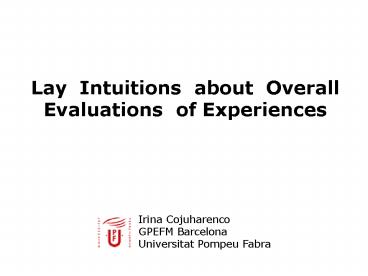Lay Intuitions about Overall Evaluations of Experiences - PowerPoint PPT Presentation
1 / 23
Title:
Lay Intuitions about Overall Evaluations of Experiences
Description:
... utility' (real-time ratings, duration-free statistics of these and duration) ... How often would you listen to this music if you had it at home? ... – PowerPoint PPT presentation
Number of Views:30
Avg rating:3.0/5.0
Title: Lay Intuitions about Overall Evaluations of Experiences
1
Lay Intuitions about Overall Evaluations of
Experiences
- Irina Cojuharenco
- GPEFM Barcelona
- Universitat Pompeu Fabra
2
Overall Evaluations of Experiences
- I would evaluate my experience in
- this concert as 7 out of 10!
- On a scale from 0 to 100 this vacation
- would deserve 60 points!
- In terms of painfulness, I would rate
- this medical procedure as 90 out of 100
3
The Importance of Overall Evaluations
- Decision input (motivation, future choices (Wirtz
et al., 2003, Oishi Sullivan, in press),
advice) - Decision target (customer satisfaction or
organizational performance, e.g. hotel stays,
employee appraisals) - What do we know about how
- overall evaluations come about?
4
Previous Research
Overall Evaluation Remembered Utility Peak-End
Rule (Kahneman, 2000) Puzzle duration
neglect (Kahneman, Wakker Sarin, 1997)
Experienced Utility Paradigm
5
Contribution
6
Experienced Utility Paradigm
Lay Intuitions
7
Motivation
- The subjective nature of overall evaluations
(Alexandrova, 2005), - Discussions of duration neglect
- (Ariely Loewenstein, 2000),
- and no research on what communication partners
expect of overall evaluations of experiences.
8
Method
Informants evaluating experiences in real-time
and overall (0-100 scale, nothing pleasant to
a great deal of pleasure) Guessers having to
infer overall evaluations by means of Active
Information Search (Huber, Wider Huber, 1997)
with only the type of experience and metrics of
evaluations known initially Closed format
questionnaires for the comparison of open-ended
and closed-format elicitation of
intuitions Interpretations of given overall
evaluations of experiences (closed format)
9
Method
Informants evaluating experiences in real-time
and overall (0-100 scale, nothing pleasant to
a great deal of pleasure) Guessers having to
infer overall evaluations by means of Active
Information Search (Huber, Wider Huber, 1997)
with only the type of experience and metrics of
evaluations known initially Closed format
questionnaires for the comparison of open-ended
and closed-format elicitation of
intuitions Interpretations of given overall
evaluations of experiences (closed format)
10
Procedure
Guessers
Informants
?
4 experiments music, chocolate, pleasant images,
aversive images 2 task conditions 3 questions /
1 question closed format questionnaires feedback
and pay
11
Music Pilot Questions and Theories
- Experienced Utility Paradigm (Kahneman, Wakker
Sarin, 1997) - Accessibility model of emotional self-report
(Robinson Clore, 2000) / Construal level theory
(Trope Liberman, 2003)/ Valence judgments
(Brendl Higgins, 1995) - Personality (Updegraff, Gable Taylor, in press)
- Value as goal supportiveness (Brendl Higgins,
1995) - Value by functional aspects (Zacks Tversky,
2000)
12
Questions Classification
Category 1. How did you rate the musical
performances of this sequence? How did you
rate the performance you liked the best? How
many performances did you hear?
- Category 1. Consistent with experienced utility
(real-time ratings, duration-free statistics of
these and duration) - Category 2. Non-chronological decomposition of
utility (functional aspects, liking of aspects,
category of experience, liking of category,
emotion specification) - Category 3. Personality
- Category 4. Decision rule
- Category 5. Impications of the overall utility
rating (future use pattern, goal supportiveness,
WTP, approach-avoidance motivations)
Category 2. What was, or, How much did you like
the rhythm of the music you listened to? Was
the music you heard classical? Was your
experience similar to your experience in a
philosophy lecture?
Category 3. Are you a person who likes variety?
Are you a generally depressed individual?
Category 4. Was your overall rating equal to the
average of performance ratings?
Category 5. How often would you listen to this
music if you had it at home? Would you use it
as a background for a romantic dinner?
13
Questions Structure
1 Question Asked to Infer Informants Evaluation
14
Questions Structure
3 Questions Asked to Infer Informants Evaluation
TQ in Total Questions Asked AP of All
Participants
15
Non-chronological decomposition of utility
16
Summary
- Common principles for interpreting overall
evaluations. Context-dependent saliency. - Duration not believed to matter for overall
evaluations. - A role for future decision-making.
17
Closed Format Questionnaires
- Guessers faced questions that could have been
asked in the - guessing task
- chose 3 that would have been most helpful
- underlined 1 they would have chosen if
constrained - Questionnaire A 9 items inspired by question
categories - found in pilot experiment (music)
- Questionnaire B 12 items inspired by
experienced utility - paradigm
18
Questionnaire A
Across Paradigms Percentage of Participants
Choosing an Item.
significantly different from random choice
(5 significance level) significantly
different from random choice (10 significance
level) __ underlined are percentages
corresponding to items chosen when participants
could choose one item only (percentages are not
reported, all significantly different from
random choice at 5 level)
19
Questionnaire B
Experienced Utility Paradigm Percentage of
Participants Choosing an Item.
20
Conclusions
- Multiple paradigms. Interactions unexplored.
- Duration not believed to matter for overall
evaluations. - Eagerness to assume overallaverage (as
dictionaries?). - Did lay intuitions reveal potential
interpretations of overall evaluations?
21
Opinions Poll
71 undergraduates rated 0-10 plausibility of
various interpretations they would give to
hearing a participant of a lab image-viewing
experiment evaluate his/her experience overall
after he/she had evaluated each image viewed.
22
Future research
- More on the use and social context of overall
evaluations. - Type of experience principles for evaluation
interaction. - Standard of measurement Utility Rating versus
Willingness-to-Pay. - Framing overall evaluations.
23
Thank You! www.econ.upf.edu/irinac For any
questions regarding this work, please, contact
Irina Cojuharenco at irina.cojuharenco_at_upf.edu





















![NOTE: To appreciate this presentation [and ensure that it is not a mess], you need Microsoft fonts: PowerPoint PPT Presentation](https://s3.amazonaws.com/images.powershow.com/6427398.th0.jpg?_=20200728051)

![NOTE:%20To%20appreciate%20this%20presentation%20[and%20ensure%20that%20it%20is%20not%20a%20mess],%20you%20need%20Microsoft%20fonts:%20%20 PowerPoint PPT Presentation](https://s3.amazonaws.com/images.powershow.com/P1246341516EizUe.th0.jpg?_=20180508106)







